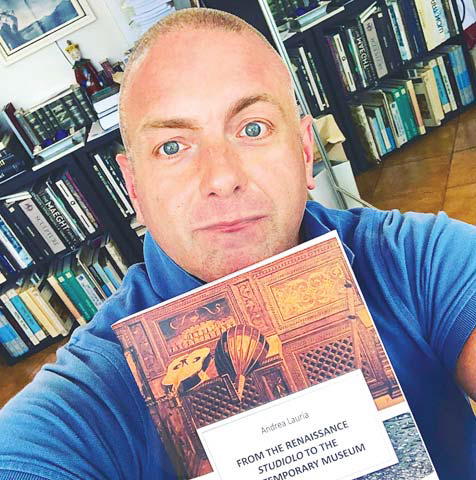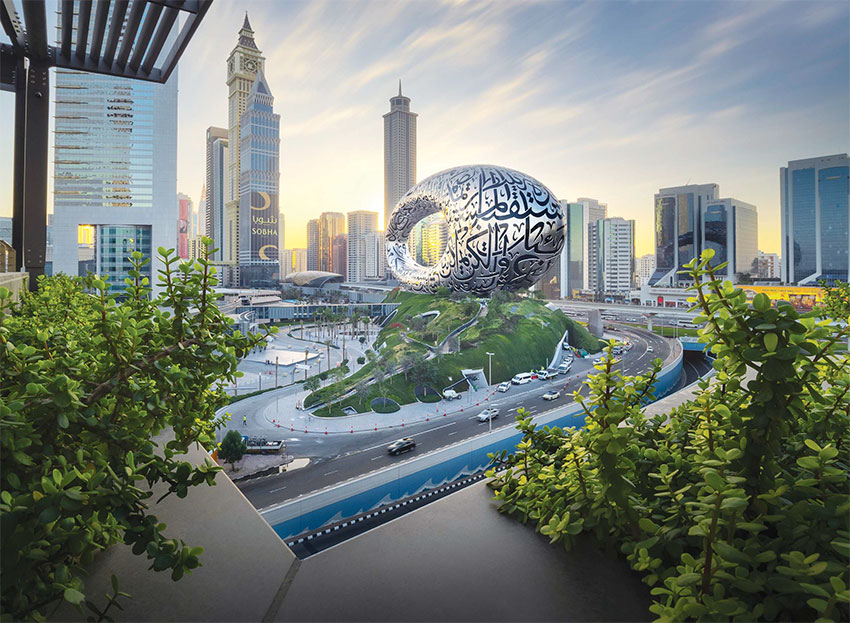08/06/2023
08/06/2023
The future belongs to those who can imagine it, design it and execute it. It isn’t something you await, but rather create

Prof. Andrea Lauria is an Italian museologist graduated from Rome’s Academy of fi ne arts. He also holds a History of Art degree from University di Roma Tre in Rome. Andrea Lauria lectures a Masters course in museology at Rome’s Universities Tor Vergata and American Temple University (Rome Campus). In 2020 he has become a published author of the book: “From the Renaissance studiolo to the contemporary museum” which is also his course manual. Lauria’s field of research is the phenomenon of hypermuseums with special attention to the Arabian countries in comparison with the western world
In my previous articles I have already mentioned the United Arab Emirates, when I wrote about the Louvre Abu Dhabi, a splendid architectural work and hyper-museum designed by the Archi star Jean Nouvel. If the Emirate of Abu Dhabi is giving life to an extraordinary project by creating a one-of-a-kind museum district on the Saadiyat Island in Abu Dhabi, the Emirate of Dubai is certainly not wasting time either. Today I will describe you the Museum of the Future (MOTF), one of Dubai’s most famous landmarks, takes pride of place along the city’s superhighway, Sheikh Zayed Road, in the Financial District of Dubai. Founded by the Dubai Future Foundation, was established in 2016 by Sheikh Mohammed bin Rashid Al Maktoum, Vice President and Prime Minister of the UAE, and Ruler of Dubai to institutionalize future-shaping.

The Dubai’s Museum of the Future opened officially on 22 February 2022. The choice of the date was officially made because 22 February 2022 is a palindrome date. The building was designed by the Killa Design studio an architecture studio based in Dubai, one of the leading architectural design firms in the region now, after this extraordinary project, mainly known for the Museum of the Future design. The Museum of the Future is certainly an extraordinary example of a hyper museum.
The museum is a strong landmark, a leading building within the urban context, with its spectacular and imposing volumes and formal and aesthetic choices that resembles a sculpture more than a building. Its aim is to amaze the viewer and as a typical hyper-museum here we can assist to the competition between the container and the content with a strong prevarication of architecture on the collection. The designer’s priority here is to turn the museum building into a spectacular building over the effectiveness of the display of the works of art preserved as, I have explained many times, typical feature of the hypermuseums.
However, I have to say though that in case of Museum of the Future it goes beyond, this architecture that triggers new questions about the museum’s concept and identity. The Museum of the Future is composed of three main elements: green hill, building, and void. Its shape, or its three elements are symbolic. The circular huge building represents humanity, the green mound it sits atop represents the Earth, the void represents the unknown future.
The main building is designed as an asymmetric torus clad in steel and glass, This torus-shaped shell sits on top of the building and comprises 1,024 fire-retardant composite panels clad in stainless steel, and each of which has a unique 3D shape to create the Arabic script. The Museum of the Future has been recognized by National Geographic as one of 14 most beautiful museums in the world. The museum’s striking exterior also stands out thanks to its artistic use of Arabic calligraphy, which functions as glass windows too. Designed by Emirati artist Mattar bin Lahej, they refl ect lines of inspirational poetry by HH Sheikh Al Maktoum. Of the three quotes enveloping the facade, one translates to: “The future belongs to those who can imagine it, design it and execute it. It isn’t something you await, but rather create.”
The Museum of the Future is an incredible land mark, the building is an architectural and engineering wonder, the museum’s shape is groundbreaking: it opens a new path away from the high rise skyscrapers that dominate perspectives everywhere. Its shape is so extraordinary it is so innovative, the building seems to have landed in the middle of the skyscrapers, which are anyway very modern, from space, from a world that we have only seen in the cinema.
As perfect hyper-museum this museum is not a simply building but it is a beautiful object, a contemporary sculpture that creates a bridge between the past and the future, mixing advanced technology with traditional art practices. Seeing this museum, one cannot fail to be impressed by its advanced design which impresses especially at night when it is light up. If the Museum of the Future’s external shape is advanced with no precedents, even the internal layout of the museum has nothing to do with the museums of the past, with what the museological tradition is to which we are familiar. Entering into the museum there are seven fl oors dedicated to several exhibitions.
Three floors are dedicated on outer space resource development, ecosystems and bioengineering, and health and wellbeing. The other floors showcase near-future technologies that address challenges in areas including health, water, food, transportation, and energy, while the last fl oor is dedicated to children.
This hyper-museum is no ordinary museum, with ancient relics behind velvet ropes, it wants to be a gateway to a future era, made by dreamer designers, artists and filmmakers. The Museum’s set up combines elements of exhibition, immersive theatre and themed attraction. This content has been crafted by a team of the world’s leading product, media, exhibition and experience designers. The visitor is always going to be surprised during the visit, each fl oor is like a movie set from a future that you can explore and interact with.
The museum explores how society could evolve in the coming decades using science and technology. The museum’s exhibition is definitely immersive, but also expansive: everything is designed to multiply what the audience thinks or dreams could be possible - for the future world. The Dubai Future Foundation was born out of a key belief: leading in the present isn’t sufficient. It is the future that we must imagine, design and execute.
The Museum builds on the visionary culture that has transformed the UAE into one of the world’s most advanced nations in less than 50 years. We are a showcase for the spirit of courage, optimism and innovation that propels Dubai forward. The Museum is a home for inspiration, open to all. if we think about the traditional museums and about centuries of museography and museology traditions, we won’t find anything like it here.
But this would be a wrong attitude The Museum of the Future is an exhibition space for advanced ideologies with the ambition to promote technological development and innovation. When we visit this museum we must be projected towards the future and think on the inspirations and ideas that this museum offers us. In the future the museum will host innovation labs dedicated to several sectors, including health, education, smart cities, energy and transport. It will also support and test new inventions in partnership with research institutes and universities. This museum is original both in its architecture and in its set up conception and must make people think about the future of museums even for those who work in the museums field like me


